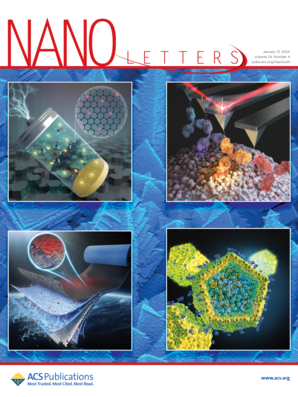Oscillatory Neural Network with Tunable Frequency for Brain-Inspired Neuromorphic Computing
IF 9.6
1区 材料科学
Q1 CHEMISTRY, MULTIDISCIPLINARY
引用次数: 0
Abstract
We present a silicon transistor-based oscillator with frequency tunability (SOFT) for brain-inspired neuromorphic computing. It consists of a single transistor-based oscillator (1T-O) and a single transistor-based resistor (1T-R), which is a nonvolatile memory device that provides conductance modulation to enable frequency tunability. Because the 1T-O and 1T-R are homologous metal-oxide-semiconductor field-effect transistors (MOSFETs), they are structurally identical but function differently. We simultaneously integrated them on the same wafer using complementary metal-oxide-semiconductor (CMOS) fabrication due to their homogeneity. We then demonstrate template matching by resistively coupling two SOFTs and classify temporal signals using first-harmonic injection locking (FHIL) with four SOFTs, leveraging their frequency tunability. This SOFT is well-suited for high-density oscillatory neural networks (ONNs) with low-cost CMOS fabrication, offering significant potential for energy-efficient and areal scalability.

基于频率可调的振荡神经网络的脑启发神经形态计算
我们提出了一种基于硅晶体管的频率可调振荡器(SOFT),用于脑启发神经形态计算。它由一个基于晶体管的单振荡器(1T-O)和一个基于晶体管的单电阻器(1T-R)组成,后者是一种非易失性存储器件,可提供电导调制以实现频率可调。由于 1T-O 和 1T-R 是同源的金属氧化物半导体场效应晶体管 (MOSFET),它们在结构上完全相同,但功能却不同。由于它们具有同源性,我们采用互补金属氧化物半导体(CMOS)制造工艺将它们同时集成在同一晶圆上。然后,我们通过两个 SOFT 的电阻耦合演示了模板匹配,并利用四个 SOFT 的频率可调性,使用首谐波注入锁定 (FHIL) 对时间信号进行了分类。这种 SOFT 非常适合采用低成本 CMOS 制造的高密度振荡神经网络 (ONN),在节能和区域可扩展性方面具有巨大潜力。
本文章由计算机程序翻译,如有差异,请以英文原文为准。
求助全文
约1分钟内获得全文
求助全文
来源期刊

Nano Letters
工程技术-材料科学:综合
CiteScore
16.80
自引率
2.80%
发文量
1182
审稿时长
1.4 months
期刊介绍:
Nano Letters serves as a dynamic platform for promptly disseminating original results in fundamental, applied, and emerging research across all facets of nanoscience and nanotechnology. A pivotal criterion for inclusion within Nano Letters is the convergence of at least two different areas or disciplines, ensuring a rich interdisciplinary scope. The journal is dedicated to fostering exploration in diverse areas, including:
- Experimental and theoretical findings on physical, chemical, and biological phenomena at the nanoscale
- Synthesis, characterization, and processing of organic, inorganic, polymer, and hybrid nanomaterials through physical, chemical, and biological methodologies
- Modeling and simulation of synthetic, assembly, and interaction processes
- Realization of integrated nanostructures and nano-engineered devices exhibiting advanced performance
- Applications of nanoscale materials in living and environmental systems
Nano Letters is committed to advancing and showcasing groundbreaking research that intersects various domains, fostering innovation and collaboration in the ever-evolving field of nanoscience and nanotechnology.
 求助内容:
求助内容: 应助结果提醒方式:
应助结果提醒方式:


